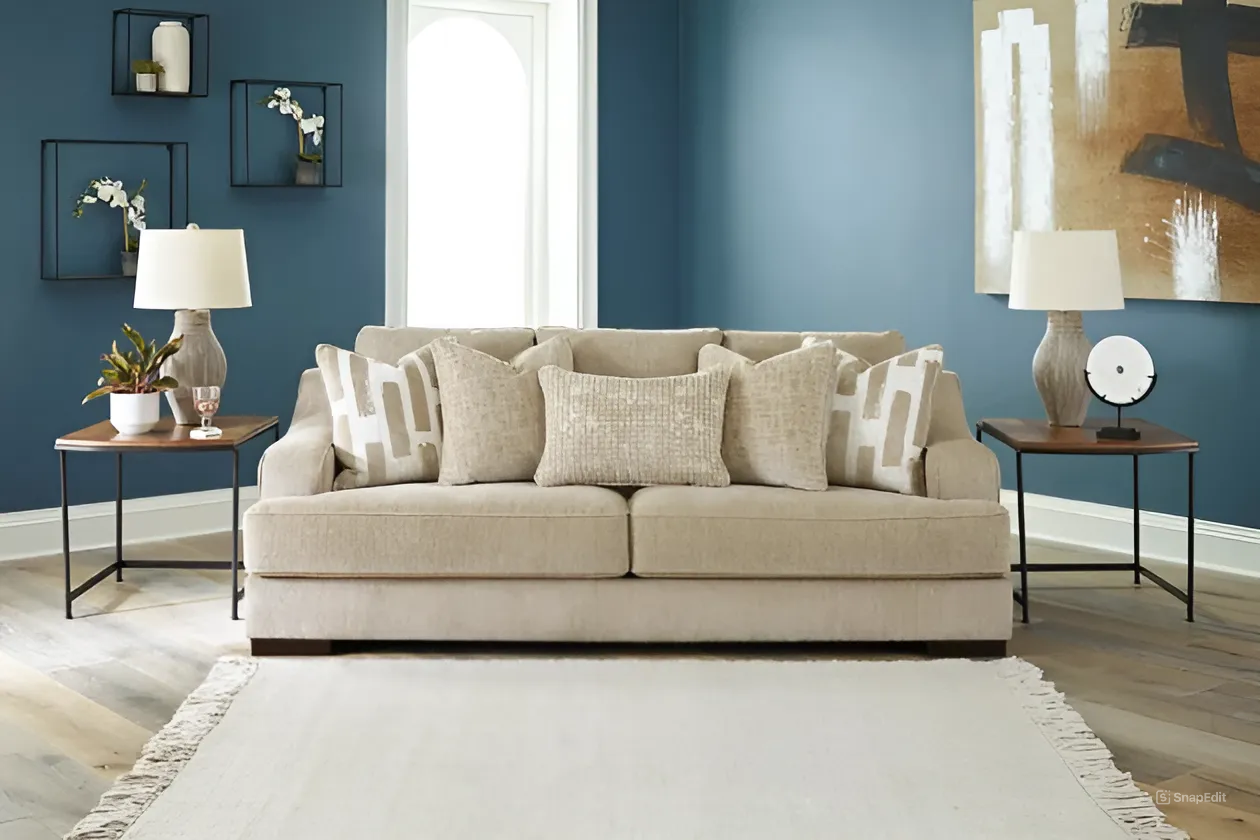
A Comprehensive Guide to Buying a Sofa (Part 3)
- Sofa Buying Tips
A sofa is a major furniture investment that will last you for decades to come so it is imperative that you make the right furniture choice.
While style is arguably subjective, there is generally an objective framework involved when it comes to selecting a high-quality sofa. Whether you are doing your sofa shopping online or in a retail store, it is essential to recognise what to look for.
From identifying the ideal seat depth to taking precise measurements of the room and furniture, you cannot go wrong following these tips when choosing a new sofa that you and your family can enjoy for a long time.
- Identify the ideal seat depth
One of the most significant things to look for when searching for a quality sofa is how well the seat depth supports the back. How deep or shallow the sofa seats should be will depend on your height.
The ideal seat depth will allow your back to be fully supported by the sofa backrest when you are in sitting position, with your feet planted firmly on the ground and the backs of your knees a few inches in front of the lower seat cushion. Most sofas have a seat depth of at least 21 to 24 inches which offers more room to move around if you have long legs, otherwise you can tuck underneath if you are shorter. However, the ideal seat depth can vary with each individual depending on your preferred sitting posture so bear this in mind when shopping for a sofa that will provide you with all the back support you need.
When seated on a sofa, do you usually sit upright or do you prefer to lean back sometimes even with your feet tucked up on the sofa? If you are the latter, then you want to go with a shorter seat depth otherwise try a deeper seat depth of at least 23 inches, or even deeper if preferred. The same rule applies to buying a recliner sofa – make sure you are able to receive optimal comfort in all the different positions.
- Invest in a sturdy frame
Unlike for the upholstery fabric and cushions, it is not realistic to replace the sofa every time it gets damaged and worn. Instead, you want to choose a quality piece of furniture with a sturdy inner frame that will last you through many years of lounging. Hence, rather than just focusing on the aesthetic choices for your sofa frame, it is wise to do some research on the sofa build before making your purchase.
Sofas frames are mainly constructed of a few selected material types. On the lower end are sofa frames made from particleboard, plastic or metal. These are prone to cracks and damage after a few years and are generally uncomfortable so avoid them if you can. A popular choice for sofa frames is softwood such as pine, cedar and redwood since they are relatively affordable and more durable compared to the aforementioned frame types. But do note that the material can start to bend and lose its shape after a period of time.
Solid hardwoods like oak, maple and beech are perhaps the most durable and long-lasting material used to construct sofa frames. The highest quality sofas typically feature hardwood compositions for this reason. Although they tend to be more expensive compared to most frame types, hardwood sofas remain a worthy investment due to their hard-wearing qualities so you are definitely getting your money’s worth.
- Ensure solid joinery
They may not be instantly noticeable but the way the different frame parts are held together is just as important as selecting a quality frame.
A stable sofa frame is joined at the corners by wooden dowels, wooden corner blocks, or metal screws and brackets, with the sofa legs either firmly attached or built into the mainframe. Avoid a sofa that is assembled with only staples, nails or glue. These items can be used to strengthen a frame but are not strong enough to be employed as the main element in a sofa’s construction. A well-constructed frame can be lifted off the ground to a height of about six inches from a corner or a leg located at the front of the sofa.
As you do this, the other front leg should also be elevated from the floor unless the frame twists, which will indicate that it is not properly assembled. Any sofa that noticeably bends or creaks is one you should stay away from.
- Prioritise hand-tied springs
Like the frame, the quality of the springs used in the sofa can vary widely and determines the level of comfort, support and durability that the sofa is able to offer. Sofas with spring fittings normally last longer compared to other compositions.
Good springs are firmly positioned adjacent to one another to provide ample support when you are seated on the sofa. Due to their incredible comfort and sturdy construct, eight-way hand tied springs are widely recognised as the standard when it comes to sofa springs. For this reason, they can be quite expensive and their use is mainly restricted to luxury sofas.
A more affordable alternative would be serpentine springs where the wires are pre-assembled into coiled, twisted sections. Go for serpentine springs made of heavier metals as lightweight ones can cause excessive pressure on the frame or lose their firmness and sag over time.
There are other forms of sofa support such as webbing but these are generally not recommended unless used in conjunction with springs to offset some of the burden from more heavily weighted areas like the seat.
- Look for durable cushion fillings
The cushion fillings can make all the difference in how comfortable a sofa is. When it comes to the best type of material for sofa cushions, the consensus is that you want something tough and enduring but at the same time snug enough to sit on for hours.
A good cushion compresses when you sit on it but will regain its form when the pressure is lifted. A cushion that remains flat when you press down essentially loses its fluff in no time which can be unsightly to look at and uncomfortable to sit on. Most sofas use durable and low-maintenance polyurethane foam for their cushion fillings. But you need to identify the fine line between a solid, long-lasting foam with reasonable firmness and a soft foam that is comfy but prone to quick disintegration.
High-resilient (HR) foam takes it up a notch. It integrates down and feather to form a hybrid type of cushion known to combine the best of durability, comfort and aesthetics as it does not need to be regularly plumped in order to retain its lush appearance. That said, sofas containing hybrid foam fillings can cost a pretty penny compared to those made of standard polyurethane foam.
- Ensure quality upholstery
Utilising quality upholstery is not always crucial to comfort, but it does determine the visual appeal of your sofa. You should thus take notice of the little things before purchasing your sofa. Whether you go for a striking colour, pattern or a neutral tone, you want to ensure that the upholstery you choose is not only up to par but also fits with your scheme.
Heavy-duty microfibre fabrics are highly regarded due to their appearance and durability. They mimic the textured details of most natural fabrics and are also stain resistant, making them an excellent choice for your sofa. The colour is also less prone to fading over time.
Steer clear of fabric made from low-quality synthetic or even those mixed with tough cotton and linen as the material can wear out quite quickly.
- Measure the space and sofa
Imagine the horror of buying the perfect piece of furniture only to realise that it does not fit into your home. So, before you make any further furniture purchases, the first step is to get out the tape measure and precisely determine the maximum sofa dimensions that will fit and suit your space.
Start by measuring the length, width and height of the area you intend to place your new sofa. Also remember to note the height and width of any necessary openings in your home so you know how much space is required to transport the furniture through the doorways. These dimensions can help you narrow down your sofa options to one that you think will fit well into the space.
Once you have a specific sofa in mind, it is good to outline the sofa’s dimensions on the floor so that you get a better picture of how the furniture will fit the space and to ensure sufficient walkway for people to traverse the room with ease.
Take down the exact width and depth of the sofa if you want to find out exactly how much space it will occupy. The width will be the length that spans the back of the sofa while the depth is the vertical distance from the back to the front of the sofa.
The sofa depth is best measured from the farthest back area before proceeding to the forwardmost point located at the front, which would usually be the sofa arms or an extended seat.


